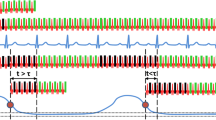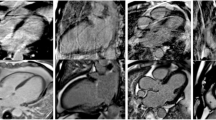Abstract
The electrocardiogram (ECG) signal is prone to distortions from gradient and radiofrequency interference and the magnetohydrodynamic effect during cardiovascular magnetic resonance imaging (CMR). Although Pilot Tone Cardiac (PTC) triggering has the potential to overcome these limitations, effectiveness across various CMR techniques has yet to be established. To evaluate the performance of PTC triggering in a comprehensive CMR exam. Fifteen volunteers and 20 patients were recruited at two centers. ECG triggered images were collected for comparison in a subset of sequences. The PTC trigger accuracy was evaluated against ECG in cine acquisitions. Two experienced readers scored image quality in PTC-triggered cine, late gadolinium enhancement (LGE), and T1- and T2-weighted dark-blood turbo spin echo (DB-TSE) images. Quantitative cardiac function, flow, and parametric mapping values obtained using PTC and ECG triggered sequences were compared. Breath-held segmented cine used for trigger timing analysis was collected in 15 volunteers and 14 patients. PTC calibration failed in three volunteers and one patient; ECG trigger recording failed in one patient. Out of 1987 total heartbeats, three mismatched trigger PTC-ECG pairs were found. Image quality scores showed no significant difference between PTC and ECG triggering. There was no significant difference found in quantitative measurements in volunteers. In patients, the only significant difference was found in post-contrast T1 (p = 0.04). ICC showed moderate to excellent agreement in all measurements. PTC performance was equivalent to ECG in terms of triggering consistency, image quality, and quantitative image measurements across multiple CMR applications.





Similar content being viewed by others
Abbreviations
- BMI:
-
Body mass index
- bSSFP:
-
Balanced steady state free precession
- CMR:
-
Cardiovascular magnetic resonance
- CO:
-
Cardiac output
- DB-TSE:
-
Dark-blood turbo spin echo
- ECG:
-
Electrocardiogram
- EF:
-
Ejection fraction
- EGE:
-
Early gadolinium enhancement
- EDV/ESV:
-
End diastolic/systolic volume
- HR:
-
Heart rate
- ICC:
-
Intra-class correlation coefficients
- LGE:
-
Late gadolinium enhancement
- MPA:
-
Main pulmonary artery
- PCA:
-
Principal component analysis
- PT:
-
Pilot Tone
- PTC:
-
Pilot Tone Cardiac
- RF:
-
Radiofrequency
- SG:
-
Self-gating
- SV:
-
Stroke volume
- TR:
-
Repetition time
References
Nacif MS, Zavodni A, Kawel N, Choi E-Y, Lima JA, Bluemke DA (2012) Cardiac magnetic resonance imaging and its electrocardiographs (ECG): tips and tricks. Int J Cardiovasc Imaging 28(6):1465–1475. https://doi.org/10.1007/s10554-011-9957-4
Snyder CJ, DelaBarre L, Metzger GJ, Van de Moortele PF, Akgun C, Ugurbil K, Vaughan JT (2009) Initial results of cardiac imaging at 7 Tesla. Magn Reson Med 61(3):517–524. https://doi.org/10.1002/mrm.21895
Abi-Abdallah D, Robin V, Drochon A, Fokapu O (2007) Alterations in human ECG due to the MagnetoHydroDynamic effect: a method for accurate R peak detection in the presence of high MHD artifacts. In: 2007 29th annual international conference of the IEEE Engineering in Medicine and Biology Society. https://doi.org/10.1109/IEMBS.2007.4352673
Dimick RN, Hedlund LW, Herfkens RJ, Fram EK, Utz J (1987) Optimizing electrocardiograph electrode placement for cardiac-gated magnetic resonance imaging. Invest Radiol 22(1):17–22
Allen J (2007) Photoplethysmography and its application in clinical physiological measurement. Physiol Meas 28(3):R1. https://doi.org/10.1088/0967-3334/28/3/R01
Frauenrath T, Hezel F, Renz W, d’Orth TDG, Dieringer M, von Knobelsdorff-Brenkenhoff F, Prothmann M, Schulz-Menger J, Niendorf T (2010) Acoustic cardiac triggering: a practical solution for synchronization and gating of cardiovascular magnetic resonance at 7 Tesla. J Cardiovasc Magn Reson 12(1):1–14. https://doi.org/10.1186/1532-429X-12-67
Dziuda L, Skibniewski FW, Krej M, Baran PM (2013) Fiber Bragg grating-based sensor for monitoring respiration and heart activity during magnetic resonance imaging examinations. J Biomed Opt 18(5):057006. https://doi.org/10.1117/1.JBO.18.5.057006
Spicher N, Kukuk M, Maderwald S, Ladd ME (2016) Initial evaluation of prospective cardiac triggering using photoplethysmography signals recorded with a video camera compared to pulse oximetry and electrocardiography at 7T MRI. Biomed Eng Online 15(1):1–28. https://doi.org/10.1186/s12938-016-0245-3
Rubin JM, Fowlkes JB, Prince MR, Rhee RT, Chenevert TL (2000) Doppler US gating of cardiac MR imaging. Acad Radiol 7(12):1116–1122. https://doi.org/10.1016/s1076-6332(00)80065-3
Jerosch-Herold M, Zanetti J, Merkle H, Poliac L, Huang H, Mansoor A, Zhao F, Wilke N (1999) The seismocardiogram as magnetic-field-compatible alternative to the electrocardiogram for cardiac stress monitoring. Int J Cardiac Imaging 15(6):523–531. https://doi.org/10.1023/a:1006364518204
Kording F, Schoennagel B, Lund G, Ueberle F, Jung C, Adam G, Yamamura J (2015) Doppler ultrasound compared with electrocardiogram and pulse oximetry cardiac triggering: a pilot study. Magn Reson Med 74(5):1257–1265. https://doi.org/10.1002/mrm.25502
Spraggins TA (1990) Wireless retrospective gating: application to cine cardiac imaging. Magn Reson Imaging 8(6):675–681. https://doi.org/10.1016/0730-725x(90)90001-i
Larson AC, White RD, Laub G, McVeigh ER, Li D, Simonetti OP (2004) Self-gated cardiac cine MRI. Magn Reson Med 51(1):93–102. https://doi.org/10.1002/mrm.10664
Buehrer M, Curcic J, Boesiger P, Kozerke S (2008) Prospective self-gating for simultaneous compensation of cardiac and respiratory motion. Magn Reson Med 60(3):683–690. https://doi.org/10.1002/mrm.21697
Han F, Rapacchi S, Hu P (2017) Prospective cardiac motion self-gating. Quant Imaging Med Surg 7(2):215. https://doi.org/10.21037/qims.2017.03.02
Ladrova M, Martinek R, Nedoma J, Hanzlikova P, Nelson MD, Kahankova R, Brablik J, Kolarik J (2021) Monitoring and synchronization of cardiac and respiratory traces in magnetic resonance imaging: a review. IEEE Rev Biomed Eng 15:200–221. https://doi.org/10.1109/RBME.2021.3055550
Speier P, Fenchel M, Rehner R (2015) PT-Nav: a novel respiratory navigation method for continuous acquisitions based on modulation of a pilot tone in the MR-receiver. Magn Reson Mater Phys Biol Med 28:S97–S98
Bacher M (2017) Cardiac triggering based on locally generated pilot-tones in a commercial MRI scanner: a feasibility study. Graz University of Technology. Master thesis
Vahle T, Bacher M, Rigie D, Fenchel M, Speier P, Bollenbeck J, Schäfers KP, Kiefer B, Boada FE (2020) Respiratory motion detection and correction for MR using the pilot tone: applications for MR and simultaneous PET/MR exams. Invest Radiol 55(3):153. https://doi.org/10.1097/RLI.0000000000000619
Falcao MBL, Di Sopra L, Ma L, Bacher M, Yerly J, Speier P, Rutz T, Prsa M, Markl M, Stuber M, Roy CW (2022) Pilot tone navigation for respiratory and cardiac motion-resolved free-running 5D flow MRI. Magn Reson Med 87(2):718–732. https://doi.org/10.1002/mrm.29023
Lin K, Sarnari R, Speier P, Hayes C, Davids R, Carr JC, Markl M (2022) Pilot tone-triggered MRI for quantitative assessment of cardiac function, motion, and structure. Invest Radiol 10:1097. https://doi.org/10.1097/RLI.0000000000000922
Speier P, Huang YT, Hayes C, Kroeker R, Rick M, Schwertfeger M, Bacher M (2022) Enabling pilot tone cardiac triggering for complete cardiac examinations using an RF calibration procedure. ISMRM, London
Bacher M, Dornberger B, Bollenbeck J, Stuber M, Speier P (2021) Listening in on the pilot tone: a simulation study. In: Proceedings of the 29th annual meeting of ISMRM, Virtual
Schulz-Menger J, Bluemke DA, Bremerich J, Flamm SD, Fogel MA, Friedrich MG, Kim RJ, von Knobelsdorff-Brenkenhoff F, Kramer CM, Pennell DJ (2020) Standardized image interpretation and post-processing in cardiovascular magnetic resonance-2020 update. J Cardiovasc Magn Reson 22(1):1–22. https://doi.org/10.1186/s12968-020-00610-6
Benjamini Y, Hochberg Y (1995) Controlling the false discovery rate: a practical and powerful approach to multiple testing. J R Stat Soc Ser B (Methodol) 57(1):289–300. https://doi.org/10.1111/j.2517-6161.1995.tb02031.x
Mackowiak AL, Roy CW, Yerly J, Falcão MB, Bacher M, Speier P, Piccini D, Stuber M, Bastiaansen JA (2023) Motion-resolved fat-fraction mapping with whole-heart free-running multiecho GRE and pilot tone. Magn Reson Med. https://doi.org/10.1002/mrm.29680
Neef S, Maier LS (2013) Novel aspects of excitation-contraction coupling in heart failure. Basic Res Cardiol 108(4):360. https://doi.org/10.1007/s00395-013-0360-2
Brookes CI, White PA, Staples M, Oldershaw PJ, Redington AN, Collins PD, Noble MI (1998) Myocardial contractility is not constant during spontaneous atrial fibrillation in patients. Circulation 98(17):1762–1768. https://doi.org/10.1161/01.cir.98.17.1762
Russell K, Smiseth OA, Gjesdal O, Qvigstad E, Norseng PA, Sjaastad I, Opdahl A, Skulstad H, Edvardsen T, Remme EW (2011) Mechanism of prolonged electromechanical delay in late activated myocardium during left bundle branch block. Am J Physiol Heart Circ Physiol 301(6):H2334–H2343. https://doi.org/10.1152/ajpheart.00644.2011
Chen C, Liu Y, Simonetti OP, Tong M, Jin N, Bacher M, Speier P, Ahmad R (2023). Cardiac and respiratory motion extraction for MRI using pilot tone–a patient study. Int J cardiovascul imag, 1–13. https://doi.org/10.1007/s10554-023-02966-z
Greulich S, Steubing H, Birkmeier S, Grün S, Bentz K, Sechtem U, Mahrholdt H (2015) Impact of arrhythmia on diagnostic performance of adenosine stress CMR in patients with suspected or known coronary artery disease. J Cardiovasc Magn Reson 17(1):94. https://doi.org/10.1186/s12968-015-0195-0
Goyal N, Mor-Avi V, Volpato V, Narang A, Wang S, Salerno M, Lang RM, Patel AR (2020) Machine learning based quantification of ejection and filling parameters by fully automated dynamic measurement of left ventricular volumes from cardiac magnetic resonance images. Magn Reson Imaging 67:28–32. https://doi.org/10.1016/j.mri.2019.12.004
Simonetti OP, Finn JP, White RD, Laub G, Henry DA (1996) “ Black blood” T2-weighted inversion-recovery MR imaging of the heart. Radiology 199(1):49–57. https://doi.org/10.1148/radiology.199.1.8633172
Acknowledgements
The authors would like to acknowledge Debbie Scandling for assistance with subject scheduling, and research radiographer Raj Kumar Soundarajan for assistance with protocol setup.
Funding
This publication was supported by Award Number R01-HL161618 from the NIH National Heart Lung and Blood Institute. Its contents are solely the responsibility of the authors and do not necessarily represent the official views of the National Heart Lung and Blood Institute or the National Institutes of Health.
Author information
Authors and Affiliations
Contributions
YP acquired a subset of volunteer and patient data at Site A, performed the analysis, and was the primary contributor in writing the manuscript. JV, NJ assisted in the scan protocol setup and data acquisition at Site A. MT assisted in the image quality and diagnostic assessment. VY provided assistance with statistical analysis. AA, PG, RW, SNV, and DP assisted in the scan protocol setup and data acquisition at Site B. MB, CH, and PS developed the technique used in this study. OPS assisted in the image quality assessment and was a major contributor in writing the manuscript. All authors read and approved the final manuscript.
Corresponding author
Ethics declarations
Competing interests
Authors MB, CH, and PS are employees of Siemens Healthcare GmbH, Erlangen, Germany. Author NJ is an employee of Siemens Medical Solutions, USA, Malvern, PA. Author OPS receives institutional research support from Siemens Medical Solutions, USA.
Ethics approval and consent to participate
The study was approved by the local institutional review boards of both institutions, and informed written consent was obtained from all subjects.
Consent to publish
The informed written consent included consent for publication.
Additional information
Publisher's Note
Springer Nature remains neutral with regard to jurisdictional claims in published maps and institutional affiliations.
Supplementary Information
Below is the link to the electronic supplementary material.
Rights and permissions
Springer Nature or its licensor (e.g. a society or other partner) holds exclusive rights to this article under a publishing agreement with the author(s) or other rightsholder(s); author self-archiving of the accepted manuscript version of this article is solely governed by the terms of such publishing agreement and applicable law.
About this article
Cite this article
Pan, Y., Varghese, J., Tong, M.S. et al. Two-center validation of Pilot Tone based cardiac triggering of a comprehensive cardiovascular magnetic resonance examination. Int J Cardiovasc Imaging 40, 261–273 (2024). https://doi.org/10.1007/s10554-023-03002-w
Received:
Accepted:
Published:
Issue Date:
DOI: https://doi.org/10.1007/s10554-023-03002-w




